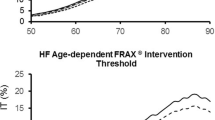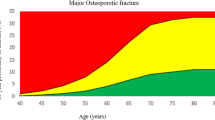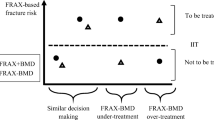Abstract
Summary
This paper revised the fixed intervention thresholds (ITs) based on the Sri Lankan fracture risk assessment tool (FRAX) published in 2013 and introduced new ITs, hybrid and two-tier, aiming to help clinicians in the management of postmenopausal osteoporosis. The hybrid and two-tier ITs have a better discriminatory power than age-dependent and revised fixed ITs.
Introduction
This study revised the Sri Lankan FRAX®-based intervention thresholds (ITs) previously published in 2013.
Method
Age-dependent ITs were estimated, from 50–80 years with 5-year intervals, using a Sri Lankan FRAX® algorithm for a woman with a BMI of 24.8 kg/m2 and history of prior fragility fracture without other clinical risk factors. Data of 653 postmenopausal women were used in estimating fixed, hybrid, and two-tier ITs. ITs were determined using the ROC curve and partial Youden index. New ITs were validated using data of 356 postmenopausal women who underwent DXA and 62 women who had a recent fragility fracture. Women in the two groups (n = 653 and n = 356) came from the Southern Province and had undergone DXA in our state-owned tertiary care hospital as a part of their routine clinical assessment.
Results
The mean (SD) age and BMI of the subjects (n = 653) were 62 (8) years and 24.8 (1.2) kg/m2, respectively. Age-dependent ITs of major osteoporotic fracture risk (MOFR) and hip fracture risk (HFR) ranged from 2.7 to 18% and from 0.4 to 7.1%. The best fixed ITs for women aged 50–80 years were 9% for MOFR and 3% for HFR. In the hybrid method, MOFR of 6% and HFR of 2% were found appropriate for women aged < 70 years. These were combined with age-dependent ITs for women aged 70 years and above. In the two-tier system, two sets of ITs were calculated (ITs of MOFR/HFR for women aged < 70 years and ≥ 70 years were 6%/2% and 12%/5%, respectively). When age-dependent ITs were considered the reference standard, sensitivities of the fixed, hybrid, and two-tier ITs were 0.63, 0.73, and 0.74, respectively. The specificities were 0.76, 0.86, and 0.80 in the same order. Sensitivities of the age-dependent, fixed, hybrid, and two-tier ITs in identifying a woman with an incident fracture were 26%, 48%, 61%, and 61%, respectively.
Conclusions
The new fixed MOFR is slightly lower than the previous value and hybrid and two-tier ITs perform better than age-dependent and fixed ITs.
Similar content being viewed by others
References
Kanis JA, Harvey NC, Johansson H, Oden A, Leslie WD, McCloskey EV (2017) FRAX update. J Clin Densitom 20:360–367
Compston J, Cooper C, McCloskey E, Kanis JA (2012) FRAX updates 2012. Osteoporos Int 24:554–560
McCloskey EV, Harvey NC, Johansson H, Kanis JA (2016) FRAX updates 2016. Curr Opin Rheumatol 28:433–441
Lippuner K, Johansson H, Borgstrom F, Kanis JA, Rizzoli R (2012) Cost-effective intervention thresholds against osteoporotic fractures based on FRAX(R) in Switzerland. Osteoporos Int 23:2579–2589
Harvey NC, Kanis JA, Oden A, Burge RT, Mitlak BH, Johansson H, McCloskey EV (2015) FRAX and the effect of teriparatide on vertebral and non-vertebral fracture. Osteoporos Int 26:2677–2684
Paulden M, O’Mahony J, McCabe C (2017) Determinants of change in the cost-effectiveness threshold. Med Decis Mak 37:264–276
Cheung E, Cheung CL, Kung AW, Tan KC (2014) Possible FRAX-based intervention thresholds for a cohort of Chinese postmenopausal women. Osteoporos Int 25:1017–1023
Lekamwasam S (2013) Sri Lankan FRAX model and country-specific intervention thresholds. Arch Osteoporos 8:148
Chandran M, McCloskey EV, Thu WPP, Logan S, Hao Y, Tay D, Ang WC, Aung TKK, Choo KS, Ali A et al (2018) FRAX(R) based intervention thresholds for management of osteoporosis in Singaporean women. Arch Osteoporos 13:130
Wu CH, McCloskey EV, Lee JK, Itabashi A, Prince R, Yu W, Li-Yu J, Chionh SB, Zhao Y, Shin CS, Gunawan T, Tsai KS, Chieng PU, Changlai SP, Chan DC, Chen JF, Tanner SB, Hans DB, Kanis JA, Chang YF, Sun ZJ, Yang RS, Asia Pacific Panel of ISCD (2014) Consensus of official position of IOF/ISCD FRAX initiatives in Asia-Pacific region. J Clin Densitom 17:150–155
Chakhtoura M, Leslie WD, McClung M, Cheung AM, Fuleihan GE (2017) The FRAX-based Lebanese osteoporosis treatment guidelines: rationale for a hybrid model. Osteoporos Int 28:127–137
Kanis JA, Harvey NC, Cooper C, Johansson H, Oden A, McCloskey EV (2016) A systematic review of intervention thresholds based on FRAX : a report prepared for the National Osteoporosis Guideline Group and the International Osteoporosis Foundation. Arch Osteoporos 11:25
Youden WJ (1950) Index for rating diagnostic tests. Cancer 3:32–35
Li C, Chen J, Qin G (2018) Partial Youden index and its inferences. J Biopharm Stat 1–15
Aubry-Rozier B, Stoll D, Krieg MA, Lamy O, Hans D (2013) What was your fracture risk evaluated by FRAX(R) the day before your osteoporotic fracture? Clin Rheumatol 32:219–223
Chen XF, Li XL, Zhang H, Liu GJ (2014) Were you identified to be at high fracture risk by FRAX(R) before your osteoporotic fracture occurred? Clin Rheumatol 33:693–698
Cosman F, de Beur SJ, LeBoff MS, Lewiecki EM, Tanner B, Randall S, Lindsay R (2014) Clinician’s guide to prevention and treatment of osteoporosis. Osteoporos Int 25:2359–2381
Compston J, Bowring C, Cooper A, Cooper C, Davies C, Francis R, Kanis JA, Marsh D, McCloskey EV, Reid DM, Selby P, National Osteoporosis Guideline Group (2013) Diagnosis and management of osteoporosis in postmenopausal women and older men in the UK: National Osteoporosis Guideline Group (NOGG) update 2013. Maturitas 75:392–396
Chen JS, Simpson JM, Blyth FM, March LM (2014) Managing osteoporosis with FRAX(R) in Australia: proposed new treatment thresholds from the 45&Up Study cohort. Bone 69:148–153
Tuzun S, Eskiyurt N, Akarirmak U, Saridogan M, Johansson H, McCloskey E, Kanis JA (2012) The impact of a FRAX-based intervention threshold in Turkey: the FRAX-TURK study. Arch Osteoporos 7:229–235
McCloskey E, Kanis JA, Johansson H, Harvey N, Oden A, Cooper A, Cooper C, Francis RM, Reid DM, Marsh D et al (2015) FRAX-based assessment and intervention thresholds--an exploration of thresholds in women aged 50 years and older in the UK. Osteoporos Int 26:2091–2099
Fujiwara S, Nakamura T, Orimo H, Hosoi T, Gorai I, Oden A, Johansson H, Kanis JA (2008) Development and application of a Japanese model of the WHO fracture risk assessment tool (FRAX). Osteoporos Int 19:429–435
Compston J, Cooper C, Jiang X, Gruner M, Tremollieres F, Pluskiewicz W, Sornay-Rendu E, Adamczyk P, Schnatz PF (2017) Diagnostic accuracy of FRAX in predicting the 10-year risk of osteoporotic fractures using the USA treatment thresholds: a systematic review and meta-analysis. Osteoporos Int 99:20–25
Kyriakos G, Vidal-Casariego A, Fernandez-Martinez MN, Blanco-Suarez MD, Ballesteros-Pomar MD, Cano-Rodriguez I (2015) Impact of the NOGG and NOF guidelines on the indication of bone mineral density in routine clinical practice. J Clin Densitom 18:533–538
Author information
Authors and Affiliations
Corresponding author
Ethics declarations
Conflicts of interest
None.
Additional information
Publisher’s note
Springer Nature remains neutral with regard to jurisdictional claims in published maps and institutional affiliations.
Rights and permissions
About this article
Cite this article
Lekamwasam, S., Chandran, M. & Subasinghe, S. Revised FRAX®-based intervention thresholds for the management of osteoporosis among postmenopausal women in Sri Lanka. Arch Osteoporos 14, 33 (2019). https://doi.org/10.1007/s11657-019-0585-2
Received:
Accepted:
Published:
DOI: https://doi.org/10.1007/s11657-019-0585-2




